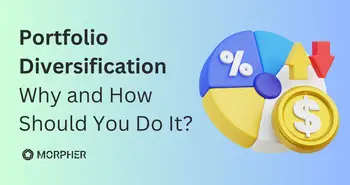Understanding the Importance of Managing Portfolio Risk

Investing in the financial markets can be an exciting and potentially rewarding endeavor. However, it is not without its risks. To ensure long-term success, it is crucial to understand and manage portfolio risk effectively. In this article, I will explain the different types of portfolio risk, discuss how it impacts your investments, highlight the role of risk management in portfolio optimization, explore the relationship between risk and return, delve into strategies for effective portfolio risk management, and examine the future of portfolio risk management.
Defining Portfolio Risk
Before we dive into the specifics of managing portfolio risk, let's establish what exactly we mean by “portfolio risk.” Put simply, portfolio risk refers to the potential for losses or underperformance in your investment portfolio. It is influenced by various factors, including market volatility, economic conditions, and individual investment choices.
When it comes to investing, risk is an inherent part of the game. The level of risk you are willing to take can greatly impact the potential returns you may receive. Understanding and managing portfolio risk is crucial for achieving long-term financial goals.
The Different Types of Portfolio Risk
Portfolio risk can manifest itself in various forms. The most common are:
- Market Risk: This type of risk stems from general market movements and affects all investments to some degree. Market risk cannot be eliminated entirely, but it can be managed through diversification and hedging strategies.
- Credit Risk: Credit risk arises when a borrower fails to repay the principal or interest on a loan or debt investment. It is crucial to conduct thorough credit analysis before investing in fixed-income securities to mitigate this risk.
- Liquidity Risk: Liquidity risk refers to the possibility of not being able to buy or sell an investment quickly enough at a fair price. Illiquid investments may pose challenges during times of financial stress or when sudden cash needs arise.
Understanding these different types of risk is essential for assessing the potential risks associated with your portfolio and implementing appropriate risk management strategies.
Market risk, in particular, is a risk that all investors face. It is influenced by factors such as economic conditions, geopolitical events, and investor sentiment. For example, during times of economic uncertainty, market risk tends to increase as investors become more cautious and market volatility rises.
Credit risk, on the other hand, is specific to investments that involve lending money. It is important to thoroughly evaluate the creditworthiness of borrowers before investing in bonds or other fixed-income securities. Failure to do so can result in a loss of principal or interest payments.
Liquidity risk is often overlooked but can have significant implications for investors. Illiquid investments, such as certain types of real estate or private equity, may offer higher potential returns but can be difficult to sell quickly if the need for cash arises. It is important to carefully consider the liquidity of an investment before committing a significant portion of your portfolio to it.
How Portfolio Risk Impacts Your Investments
Portfolio risk has a direct impact on your investments. When the overall risk level in your portfolio is high, you are exposed to a greater probability of losses. Conversely, when risk is managed effectively, the potential for higher returns is increased.
Consider this personal story: Early in my investing journey, I failed to adequately manage portfolio risk and focused solely on chasing high returns. Unfortunately, I learned the hard way that high returns often come with higher risks. When the market took a downturn, my portfolio suffered significant losses. This experience taught me the invaluable lesson of prioritizing risk management alongside return potential.
Managing portfolio risk requires a balanced approach. It involves diversifying your investments across different asset classes, industries, and geographic regions to reduce the impact of any single investment on your overall portfolio. Additionally, implementing risk management strategies such as stop-loss orders and regularly reviewing and rebalancing your portfolio can help mitigate potential losses.
It is important to note that risk tolerance varies from investor to investor. Some individuals may be more comfortable taking on higher levels of risk in pursuit of potentially higher returns, while others may prioritize capital preservation and opt for lower-risk investments.
Ultimately, understanding and managing portfolio risk is an ongoing process. It requires staying informed about market trends, conducting thorough research, and regularly reassessing your investment strategy to ensure it aligns with your financial goals and risk tolerance.
The Role of Risk Management in Portfolio Optimization
Risk management plays a vital role in portfolio optimization, which aims to maximize returns while minimizing risk. By employing effective risk management practices, you can enhance the resilience of your portfolio and improve the likelihood of achieving your investment goals.
When it comes to portfolio optimization, it is important to understand that risk is an inherent part of investing. However, by implementing robust risk management strategies, you can mitigate potential losses and increase the potential for long-term success.
One of the key principles of risk management is diversification. Diversifying your portfolio across different asset classes, industries, and geographies can reduce the impact of specific risks and help increase overall portfolio stability. For example, if you have a portfolio heavily concentrated in a single industry and that industry experiences a downturn, your entire portfolio may suffer significant losses. However, by diversifying your investments across various industries, you can spread the risk and potentially offset any losses.
Asset allocation is another important principle of risk management. Allocating your investments across different asset classes based on your risk tolerance and investment objectives can help balance risk and potential returns. For instance, if you have a higher risk tolerance, you may allocate a larger portion of your portfolio to stocks, which have the potential for higher returns but also higher volatility. On the other hand, if you have a lower risk tolerance, you may allocate a larger portion of your portfolio to bonds, which tend to be less volatile but offer lower returns.
Continual monitoring is crucial for effective risk management. Regularly reviewing and adjusting your portfolio based on changing market conditions and your individual circumstances can help you stay on track towards your investment goals. By staying informed about market trends, economic indicators, and geopolitical events, you can make informed decisions and take appropriate actions to protect your portfolio from potential risks.
Tools and Techniques for Managing Risk
To implement risk management effectively, various tools and techniques are available:
- Stop-loss orders: Placing stop-loss orders can help limit potential losses by automatically selling an investment if it reaches a predetermined price. This tool allows you to set a threshold at which you are willing to exit a position, thereby protecting yourself from further downside risk.
- Hedging strategies: Hedging involves using financial instruments, such as options or futures, to offset potential losses in your portfolio. It can serve as a valuable risk management tool in uncertain market conditions. For example, if you hold a significant amount of stocks and anticipate a market downturn, you can purchase put options to protect your portfolio from potential losses.
- Portfolio stress testing: Stress testing involves simulating potential adverse scenarios to assess how your portfolio would perform and identify potential weaknesses. By subjecting your portfolio to various stress scenarios, such as a market crash or an economic recession, you can evaluate its resilience and make necessary adjustments to mitigate potential risks.
By employing these tools and techniques, you can effectively manage portfolio risk and navigate through volatile market conditions with more confidence. It is important to note that risk management is an ongoing process that requires continuous monitoring and adjustment. As market conditions change and new risks emerge, it is essential to adapt your risk management strategies accordingly to protect your portfolio and achieve your investment objectives.
The Relationship Between Risk and Return
Understanding the relationship between risk and return is fundamental to successful investing. Generally, investments with higher potential returns tend to carry higher levels of risk. However, this relationship is not always linear, and prudent risk management can enhance returns even in riskier investments.
When it comes to investing, risk and return go hand in hand. The concept is simple: the higher the potential return, the higher the risk. This is because investments that offer the possibility of greater profits often come with a greater chance of loss. For example, investing in stocks can yield significant returns, but it also carries the risk of market volatility and the potential for loss of principal.
While it may be tempting to chase after high returns, it is important to remember that risk tolerance varies from person to person. Some investors are comfortable taking on more risk in pursuit of higher returns, while others prefer a more conservative approach. Determining your risk tolerance is crucial in building a successful investment strategy that aligns with your financial goals and comfort level.
Balancing Risk and Return in Your Portfolio
Striking the right balance between risk and return is a key consideration. As an investor, it is important to establish a risk tolerance level that aligns with your financial goals, time horizon, and comfort with volatility. Investing too conservatively may result in lower returns, while being excessively aggressive magnifies the potential for substantial losses.
When constructing your investment portfolio, diversification is a strategy that can help manage risk while seeking returns. Diversification involves spreading your investments across different asset classes, sectors, and regions. By doing so, you can potentially reduce the impact of individual investment failures and enhance overall portfolio stability.
For example, let's say you have a portfolio consisting solely of technology stocks. If the technology sector experiences a downturn, your entire portfolio could suffer. However, if you had diversified your holdings to include stocks from other sectors such as healthcare or consumer goods, the losses in the technology sector may be offset by gains in other areas.
The Impact of Diversification on Risk and Return
Diversification is one of the most effective strategies for managing risk while seeking returns. By spreading investments across different asset classes, sectors, and regions, you can potentially reduce the impact of individual investment failures and enhance overall portfolio stability. A diversified portfolio can provide a smoother investment experience by offsetting losses in one area with gains in others.
Furthermore, diversification can also help protect against specific risks associated with certain investments. For example, if you invest solely in real estate, your portfolio may be vulnerable to fluctuations in the housing market. However, by diversifying your holdings to include stocks, bonds, and other asset classes, you can reduce the impact of any single investment's performance on your overall portfolio.
It is important to note that diversification does not guarantee a profit or protect against loss. However, it can help manage risk and potentially improve your chances of achieving your investment goals. By carefully selecting a mix of investments that align with your risk tolerance and diversifying across various asset classes, you can create a well-rounded portfolio that balances risk and return.
Strategies for Effective Portfolio Risk Management
Having a sound risk management strategy is crucial for long-term success. Here are two key strategies to consider:
Asset Allocation as a Risk Management Strategy
Asset allocation refers to the strategic distribution of investments across different asset classes, such as stocks, bonds, and cash equivalents. By diversifying investments across asset classes with varying levels of risk and return potential, asset allocation aims to balance risk and enhance the stability of your portfolio.
The Role of Hedging in Risk Management
Hedging involves taking offsetting positions or using derivative instruments to protect your portfolio against potential losses. While hedging does not eliminate risk entirely, it can help mitigate the impact of adverse market movements. Hedging strategies are particularly useful during periods of heightened volatility or when specific risks are expected.
The Future of Portfolio Risk Management
Risk management practices continually evolve to keep pace with market dynamics and technological advancements. Here are two key trends shaping the future of portfolio risk management:
Technological Advances in Risk Management
Advancements in technology, such as artificial intelligence (AI) and machine learning, are revolutionizing risk management practices. These innovative tools enable investors to analyze vast amounts of data, identify patterns, and make more informed risk management decisions.
The Impact of Global Trends on Portfolio Risk Management
Global trends, such as geopolitical events and climate change, have significant implications for portfolio risk management. These factors can introduce new risks and affect investment performance. It is crucial for investors to stay informed about global trends and adapt their risk management strategies accordingly.
Understanding the importance of managing portfolio risk is essential for long-term investment success. By identifying and managing the various types of risk, implementing effective risk management strategies, and keeping abreast of market trends, you can navigate the financial markets with confidence and increase the likelihood of achieving your investment goals.
FAQ
What is portfolio risk?
Portfolio risk refers to the potential for losses or underperformance in your investment portfolio. It encompasses various factors, including market volatility, economic conditions, and individual investment choices.
How does portfolio risk impact my investments?
Portfolio risk directly influences your investments. When risk is high, there is a greater probability of losses. Conversely, effective risk management can increase the potential for higher returns.
What are some strategies for effective portfolio risk management?
Two key strategies for effective portfolio risk management are asset allocation and hedging. Asset allocation involves diversifying investments across different asset classes, while hedging aims to protect against potential losses through offsetting positions or derivative instruments.
What is the future of portfolio risk management?
The future of portfolio risk management is shaped by technological advances, such as artificial intelligence and machine learning, which enhance risk analysis capabilities. Additionally, global trends, such as geopolitical events and climate change, significantly impact portfolio risk management practices.
Ready to take control of your investment journey with a platform that understands the importance of managing portfolio risk? Look no further than Morpher, the revolutionary trading platform that leverages blockchain technology for a seamless, fee-free trading experience. With features like fractional investing, short selling without interest fees, and up to 10x leverage, Morpher empowers you to optimize your portfolio like never before. Sign up now to experience the future of trading and receive your Free Sign Up Bonus.

Disclaimer: All investments involve risk, and the past performance of a security, industry, sector, market, financial product, trading strategy, or individual’s trading does not guarantee future results or returns. Investors are fully responsible for any investment decisions they make. Such decisions should be based solely on an evaluation of their financial circumstances, investment objectives, risk tolerance, and liquidity needs. This post does not constitute investment advice.

Painless trading for everyone
Hundreds of markets all in one place - Apple, Bitcoin, Gold, Watches, NFTs, Sneakers and so much more.

Painless trading for everyone
Hundreds of markets all in one place - Apple, Bitcoin, Gold, Watches, NFTs, Sneakers and so much more.









